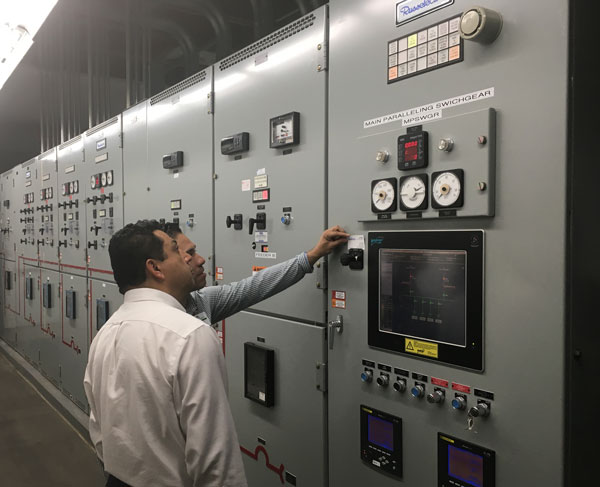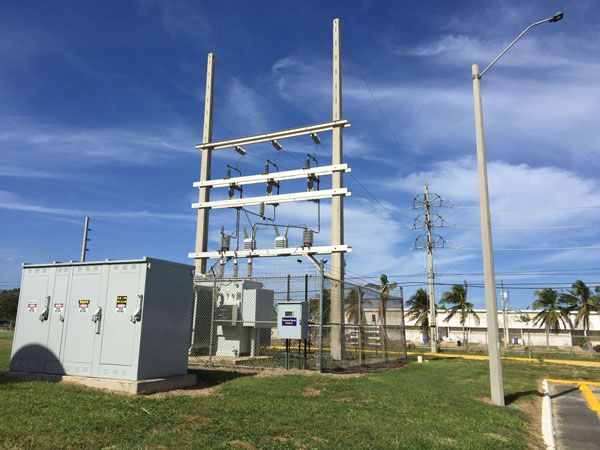
The days and weeks following a natural disaster are a critical time for residents, emergency response teams and government entities to recover and rebuild infrastructure. Recovery can be time consuming, and rebuilding after disaster presents a critical juncture that requires methodical planning; however, few communities rebuild with resilience in mind.
Sandia’s microgrid team hopes to change that.
A microgrid is electrical infrastructure that uses a system of power generation and automatic control to link buildings and other assets in a designated area, ensuring access to electricity for these buildings even if the power grid goes down. Sandia refers to these groups of microgrid buildings as resilience nodes because they assure access to essential services and allow for response and recovery after electric grid disruptions.
Island and rural communities present a unique opportunity for resilience research and development. Sandia, along with various partners, has developed a microgrid resilience modeling tool to help identify critical infrastructures in isolated and island communities.
The Sandia-developed Microgrid Design Toolkit characterizes the trade-space and provides what-if analysis of design choices to provide quantitative insights to decision makers for hybrid energy solutions. Using the MDT tool, utilities or other community stakeholders, such as universities, can identify vulnerabilities in infrastructure particularly susceptible to natural disasters and related consequences. Cities and communities can then use the model to inform future building, policies and emergency response plans.
The MDT couples an advanced design-level optimization search algorithm with a microgrid sizing capability that determines the cost versus load payment on all proposed microgrid placements. Using these algorithms and models, researchers can identify a net present value for day-to-day micro-grid load to eventually reach a profitable outcome.
Puerto Rico, phase one
After Hurricane Maria in September 2017, Puerto Rican dependence on local electric supply prompted DOE-funded research on grid modernization and improvement. As part of this research, Sandia worked alongside the Puerto Rico Industrial Development Corporation to deploy six microgrid demo sites across the island.
These sites were intended to generate power to key infrastructure buildings, such as hospitals, during a time when the Puerto Rican Emergency Relief Administration could not address all critical power needs on the island. The demo sites were also used to develop replicable microgrids intended for use across the island and eventually in other rural, isolated communities.
In addition to the focus on rebuilding resilient infrastructure, the research team was faced with the additional burden of presenting a resilience plan that could be stood up in a condensed timeframe to assure residents have access to critical resources. The first phase of Puerto Rico resilience work focused on identifying opportunities to understand the community and critical infrastructure and ways to reduce societal burden.
Sandia researcher Bobby Jeffers said the societal burden is, “how hard people have to work to get critical infrastructure needs satisfied. It is determined by the level of effort required for people to satisfy their needs, divided by their overall ability.
“The higher the effort and lower the ability, the greater the societal burden,” he said. Societal burden metrics can include shelter, food, water or other critical needs, and can be quantified by city zone, district, census block or general geographic region.
Results from this multi-lab collaborative discussion informed a federal report to Congress to justify application for Federal Emergency Management Agency funding in 2018.
Puerto Rico, phase two

The second phase of resilience work in Puerto Rico includes capacity building and workforce development. The phase two team is developing the Resilience Node Cluster Analysis Tool, which optimizes locations for microgrids across a large planning region focused on decreasing societal burden at least cost.
Phase two also incorporates use of the quasi-static time series, which assesses the time-dependent aspects of power flow, frequency and possible impacts of photovoltaic deployment on the grid. The energy resilience team won a Sandia Employee Recognition Award for this work, particularly for their effort to “hold the grid together and keep the transmissions lines in use after disasters,” manager Ray Byrne said.
The team continues to work on ReNCAT 2.0, which will incorporate additional cost variables such as blue-sky benefits. ReNCAT couples with MDT to provide a holistic cost benefit and societal burden analysis of any geographic region. Additional future work includes development of an explicit QSTS algorithm that no longer requires manual review of grid topology to automatically pinpoint opportunities for maximum community benefits and grid constraints.
In an ongoing effort to expand application of both MDT and ReNCAT, the Office of International Affairs and State Department are currently working with Sandia to identify resource sharing among other islands in the region, providing an additional energy fail-safe. Most funding is provided by DOE, with additional FEMA funding in the U.S. Virgin Islands and Puerto Rico. Through continued efforts, Sandia hopes to assure resilience is an essential reliability service, providing access to basic needs such as safety, security, communications, health and transportation in the wake of disasters.
After Hurricane Maria hit the Caribbean in 2017, DOE funded a partnership that included Sandia, FEMA and Housing and Urban Development to develop assessment tools for resilience-focused rebuilding. This effort to focus on resilience during a rebuilding period presented a paradigm shift, as most rebuilding work tended to focus only on rebuilding key infrastructure and not on rebuilding with resilience in mind.
“The rebuilding focuses on providing utility access and regulatory support as soon as possible after a disaster,” said former Sandia manager Abraham Ellis. “Whereas, without the tool, some areas of Puerto Rico could be without power for six to twelve months.”
Sandia’s MDT tool provides a rigorous, quantitative approach to analyze macro and micro-scale environments within a defined framework. This framework includes tools, procedures and metrics to develop a defensible and reasonable plan based on current state and future state resilience. Puerto Rico precipitated action in the energy resilience space to the U.S. Virgin Islands and similar rural, island-like environments.
DOE’s support and Sandia’s research and development expertise were showcased during a multi-lab effort to further develop resilience metrics around societal burden and critical need access. Two such studies include resilience research in Norfolk, Virginia, and New Orleans, Louisiana. These studies are informed by a universal framework based on infrastructure modeling, simulations and algorithms. The models inform risk assessment and Sandia’s systems analysis to pinpoint areas of concern as well as areas that present the most opportunity for resilience.
The study in Norfolk assessed how the city and region could be adversely affected by a natural disaster, namely rising sea levels. Norfolk was identified as a critical resource center, as it is home to the world’s largest naval station and critical seaports. With the help of Sandia, Norfolk pinpointed key areas in the city that were less likely to be affected by flooding. The city was then able to develop policies and procedures to better prepare infrastructure, should the city flood.
Similarly, Sandia and Los Alamos national laboratories partnered with the City of New Orleans to pinpoint opportunities for resilience, including support of key services in the wake of natural disasters, such as hurricanes. The team used historical flood data and forward-looking flood models to illustrate how severe flooding could isolate various portions of the community from electrical supply and lifeline services.
Sandia developed a tool to identify key community resources, such as hospitals and grocery stores, that were less likely to be affected by flooding and more likely to be useful after a hurricane. Based on these flooding models, cities and governments can identify opportune locations for microgrid placement that will provide access to critical infrastructure, should the city flood.
Much of the ongoing microgrid work in Puerto Rico was informed by studies of mainland cities and regions. There is a dire need to focus research and infrastructure efforts on rural, isolated and island settings, such as Puerto Rico, the U.S. Virgin Islands and arctic communities, due to their susceptibility to power outages. Because certain locations are key to national security, microgrids for resilience has gained firm support from DOE as a new research and development space.
“There are a lot of similarities and parallels between rural and remote and arctic and island communities,” Abraham said. “Our goal is to reduce to societal burden after an outage regardless of geographic region… For now, our focus is Puerto Rico and the Caribbean, but eventually we could take this to other island nations or the Arctic.”
The team would like to remember Bill Fogleman, a Sandia contractor who was critical to the phase two Puerto Rico resilience project work. Bill passed away in late April. He will be missed.